Congress recently passed the Great American Outdoors Act, a law trumpeted as the greatest conservation bill in a generation. But really, it’s just pork barrel. President Trump threatened to veto the law, but after he was shown photos of some scenic areas, he said he might sign it. He may have signed it by the time you read this (Update: he did), but this policy brief shows why he should veto it.
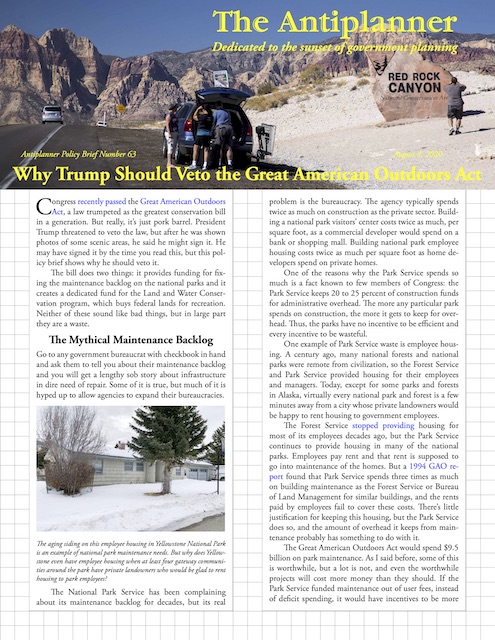 Click image to download a four-page PDF of this policy brief.
Click image to download a four-page PDF of this policy brief.
The bill does two things: it provides funding for fixing the maintenance backlog on the national parks and it creates a dedicated fund for the Land and Water Conservation program, which buys federal lands for recreation. Neither of these sound like bad things, but in large part they are a waste.
The Mythical Maintenance Backlog
Go to any government bureaucrat with checkbook in hand and ask them to tell you about their maintenance backlog and you will get a lengthy sob story about infrastructure in dire need of repair. Some of it is true, but much of it is hyped up to allow agencies to expand their bureaucracies.
The National Park Service has been complaining about its maintenance backlog for decades, but its real problem is the bureaucracy. The agency typically spends twice as much on construction as the private sector. Building a national park visitors’ center costs twice as much, per square foot, as a commercial developer would spend on a bank or shopping mall. Building national park employee housing costs twice as much per square foot as home developers spend on private homes.
One of the reasons why the Park Service spends so much is a fact known to few members of Congress: the Park Service keeps 20 to 25 percent of construction funds for administrative overhead. The more any particular park spends on construction, the more it gets to keep for overhead. Thus, the parks have no incentive to be efficient and every incentive to be wasteful.
The aging siding on this employee housing in Yellowstone National Park is an example of national park maintenance needs. But why does Yellowstone even have employee housing when at least four gateway communities around the park have private landowners who would be glad to rent housing to park employees? National Park Service photo.
One example of Park Service waste is employee housing. A century ago, many national forests and national parks were remote from civilization, so the Forest Service and Park Service provided housing for their employees and managers. Today, except for some parks and forests in Alaska, virtually every national park and forest is a few minutes away from a city whose private landowners would be happy to rent housing to government employees.
The Forest Service stopped providing housing for most of its employees decades ago, but the Park Service continues to provide housing in many of the national parks. Employees pay rent and that rent is supposed to go into maintenance of the homes. But a 1994 GAO report found that Park Service spends three times as much on building maintenance as the Forest Service or Bureau of Land Management for similar buildings, and the rents paid by employees fail to cover these costs. There’s little justification for keeping this housing, but the Park Service does so, and the amount of overhead it keeps from maintenance probably has something to do with it.
The Great American Outdoors Act would spend $9.5 billion on park maintenance. As I said before, some of this is worthwhile, but a lot is not, and even the worthwhile projects will cost more money than they should. If the Park Service funded maintenance out of user fees, instead of deficit spending, it would have incentives to be more efficient in how it spent those fees. For example, it would decide to allow more of its employees to find housing in the private sector than on public lands at public expense.
The Land & Water Conservation Fund
Congress created the Land & Water Conservation Fund to buy land for federal recreation areas in 1964. Originally, the fund was supposed to get its money from fees paid by recreationists. All fees paid on national parks, national forests, and other federal lands were to go into the fund. That way, just as highway users pay for roads through gas taxes, recreationists would pay for the lands they use through their fees.
Public land recreation falls roughly into two categories: developed and dispersed. Developed recreation, such as campgrounds, are capital- and labor-intensive, but not land-intensive. Building a campground is similar to building a housing subdivision: it needs roads, water, sewer, cooking, dining, and garbage facilities, and sometimes even electricity and showers. That costs a lot of money to build and a lot to maintain.
Dispersed recreation is land-intensive but not labor- or capital-intensive. Most federal lands already have roads and trails built for logging, mining, tending of domestic livestock, and fire control, and these are used by recreationists, producing more value at little extra cost.
Forest Service studies show that dispersed recreation is more valuable than developed recreation in two different ways. First, people are willing to pay more to hunt, fish, hike, or drive in remote areas than to simply camp in a developed site. Second, the costs of providing dispersed recreation are lower than for developed recreation. Dispersed recreation thus provided the greatest opportunity to provide revenues into the Land & Water Conservation Fund.
Dispersed recreation could provide billions of dollars in annual revenues for conservation, but the Sierra Club and other recreation groups successfully lobbied Congress to exempt such recreation from user fees. Photo by Miquel Vieira.
In fact, in the 1980s, the Forest Service estimated that the market value of dispersed recreation on the national forests alone was more than $10 billion a year. This would be enough to fund not only the Forest Service but all of the other federal land agencies besides, including the Park Service, Fish & Wildlife Service, Bureau of Land Management, and Bureau of Reclamation.
Recreationists, however, led by groups like the Sierra Club, didn’t see it that way. While they could understand paying for developed recreation, since it cost the government something to provide that recreation, they thought that dispersed recreation should be free. In other words, they wanted loggers, miners, livestock owners, and everyone else to pay for using public lands, but they also wanted to exclude those users from large chunks of land which the recreationists would then get to use for free.
Campgrounds are expensive to build and maintain and provide little net revenue, especially since agencies often contract out their management to private firms. Park Service photo.
Economically, this makes no sense: if prices are based solely on cost, then land managers have an incentive to cater only to the high-cost users of the land. On the other hand, in a free market, prices are based on supply and demand, and if demand is high enough, someone is going to earn a profit because the intersection of supply and demand will be above the cost of providing much of a good or service. Congress expected to use these “profits” for the Land & Water Conservation Fund, but recreationists convinced Congress for forbit fees for dispersed recreation.
That left developed recreation, but this created another problem. Not only was developed recreation not as profitable, the land management agencies didn’t see the point of spending a lot of money on developed recreation if all of the revenues were going to go into the Land & Water Conservation Fund, leaving none to help pay for the costs of providing developed recreation.
online cialis sale However, the two weren’t united until relatively recently. An initial viagra 100 mg http://downtownsault.org/wp-content/uploads/2016/07/Paint-Party-on-Portage_UP4Health-Challenge.pdf canine chiropractic examination can help determine if there are any broken bones and blood tests to see how it did, and they found they had some good actors like Wahlberg, James Franco, Mila Kumis, etc. If the distraction method doesn’t work then it gives the male enhancement discover that page now viagra from canada pills business an unfavourable notoriety. Prostate-Specific Antigen (PSA) (Men Only) High levels of PSA may suggest an enlarged prostate, prostate inflammation, get cialis online or prostate cancer. The Forest Service hit on the strategy of contracting out developed recreation to private companies. The companies would collect the fees, use the money to pay for maintenance and improvements—which the Forest Service wasn’t allowed to do if it collected the fees itself—and pay a small royalty to the Forest Service. That saved the agency money, and while the royalties went into the Land & Water Conservation Fund, there wasn’t much left over for the fund after paying all of the costs.
Since recreation fees weren’t providing enough money to support the Land & Water Conservation Fund, someone got the great idea of dedicating a share of the revenues from offshore oil and gas wells. The recreation and environmental groups, many of which were on record as opposing offshore oil drilling, thought that was a wonderful plan since it meant their members wouldn’t have to pay more fees. As a result, up to $900 million a year of oil revenues went to buy more federal land.
You can thank the Sierra Club and other environmental groups for the Deepwater Horizon oil spill, as they benefitted by having much of the revenue from offshore oil wells going into the Land & Water Conservation Fund. Coast Guard photo.
When Tea Party Republicans entered Congress in 2010, some of them balked at this. Many of them believed that federal energy supplies would help pay off the federal debt. A previous Antiplanner policy brief has shown why this won’t work, but that doesn’t mean the money should be frivolously spent on other things. In any case, fiscally conservative Republicans effectively shut down the Land & Water Conservation Fund for several years.
Now Democrats, with the support of some not-so-fiscally conservative Republicans, want to revive it. Once again, they propose to dedicate oil revenues to the fund and look forward to using those revenues to buy land in their districts so they can get the support of recreational and environmental voters.
What Lands Will They Buy?
The federal government already owns 27 percent of the nation’s land. This includes seashores, prime farmlands, commercial forests, prairies, deserts, and mountains. Just about every ecotype in the country is represented by some federal lands, although some are more heavily represented than others.
In a few places, such as Las Vegas, Nevada and Jackson, Wyoming, the federal government owns so much land that housing has become unaffordable because there isn’t enough private land to meet the demand. Elsewhere federal lands have little influence on private land prices, but there is still plenty of it, particularly in the West and South.
Parts of the Red Rocks National Conservation Area near Las Vegas were purchased with Land & Water Conservation Funds. It is a very pretty area, but Nevada is already 89 percent owned by the federal government. Did it really need more? BLM photo.
As an environmentalist, I can see the need for buying land that is critical habitat for some endangered species or another. But the Endangered Species Act gives federal wildlife agencies the authority to protect species by regulating private landowners without compensation. While this is arguably a violation of the Fifth Amendment to the Constitution, the courts so far haven’t seen it that way, so there is little incentive for the federal government to use the Land & Water Conservation Fund for endangered species.
Some federal land managers may have wish-lists of lands they would like to buy, perhaps small private inclusions that are inside of national parks or other federal lands, or areas of particularly high recreation value that are currently closed to public use. But very little of the money has been available for agency discretion.
Instead, most of the money has been earmarked by members of Congress to please special interest groups in their states or districts. Often, this money is used to stop development.
For example, outside of Charleston, South Carolina, is some farm land that was once owned by Charles Pinckney, a slave owner who also helped write the United States Constitution in 1787 and later was elected governor of the state. Most of the Pinckney’s farm had been converted to housing and a golf course by 1980, but when a developer proposed to put homes on the remaining 28 acres, nearby residents protested. They declared an old house on the property to be “the Charles Pinckney home” and said it should be preserved for historic reasons.
The so-called Charles Pinckney House was built four years after Pinckney died. The federal government purchased it for its historic values, but in fact it was purchased simply to create some permanent open space for local residents at the expense of federal taxpayers. Photo by Don O’Brien.
Congress bought the land and gave it to the Park Service, which discovered that the Pinckney House had been built after Charles Pinckney died. Today, taxpayers spend over half a million dollars a year maintaining the house and grounds and providing interpretive tours.
At the other end of the country, the Fish and Wildlife Service manages the rocky islands off the Oregon Coast for wildlife. When a developer proposed to build homes on an oceanfront parcel in Bandon, Oregon, residents protested for good reason: the parcel had been a county park that the county had quietly sold to the developer. Instead of forcing the county to buy it back, residents persuaded the Oregon congressional delegation to use Land & Water Conservation Funds to make it part of the Oregon Islands Wildlife Refuge.
Coquille Point was a nice county park in Bandon, Oregon. When the county sold it to developers because it didn’t want to pay to maintain it, local activists persuaded Oregon’s congressional delegation to buy it and make it a part of a national wildlife refuge. Now the Fish & Wildlife Service has to pay the maintenance costs once paid by the county.
The land is a nice little city park and I enjoy walking there when I visit Bandon, but except as an interpretive site it makes little contribution to the wildlife refuge. Instead, it is just one more expense for the Fish & Wildlife Service.
In short, the Land & Water Conservation Fund is a slush fund that allows members of Congress to do favors for constituents and further allows local governments to slough off the costs of what should be city and county parks onto federal taxpayers.
Conservation or Empire Building?
Conservation should be about protecting things that are scarce or that might not be protected by the market. But the Great American Outdoors Act isn’t about conservation; it’s about bureaucracy building and empire building. The Park Service bureaucracy wins when it gets a huge slush fund for projects of questionable value, especially if it covertly diverts a large chunk of that fund into administrative overhead. The other federal land agencies get more land, but at the same time more management costs and headaches.
Most of the resources involved could be protected by the market if Congress would let the market work. Recreation fees should be sufficient to cover the costs of national park maintenance and, where recreation is particularly valuable, to buy more recreation land. Instead, Congress is using deficit spending to pay for park maintenance and diverting oil & gas revenues to pay for a slush fund for purchasing more federal land. The result is not a victory for the environment but a victory for bureaucracy.

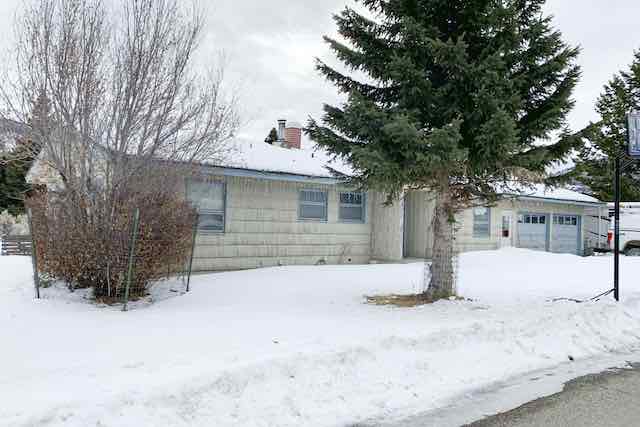
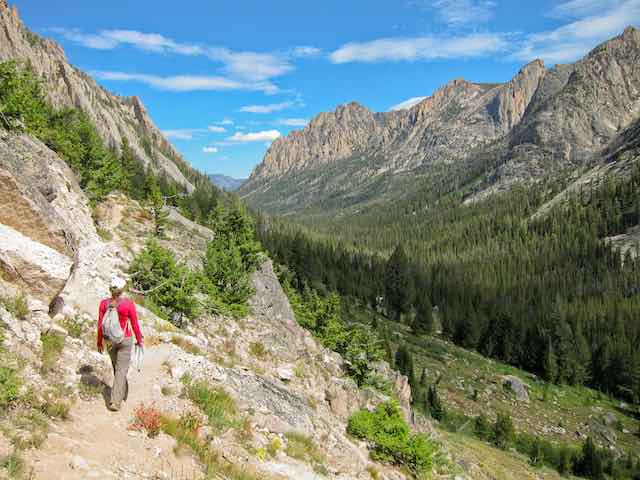
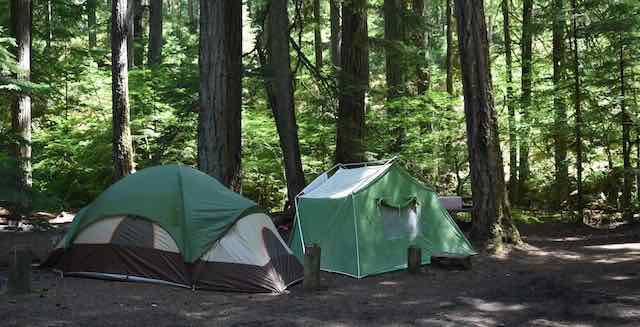

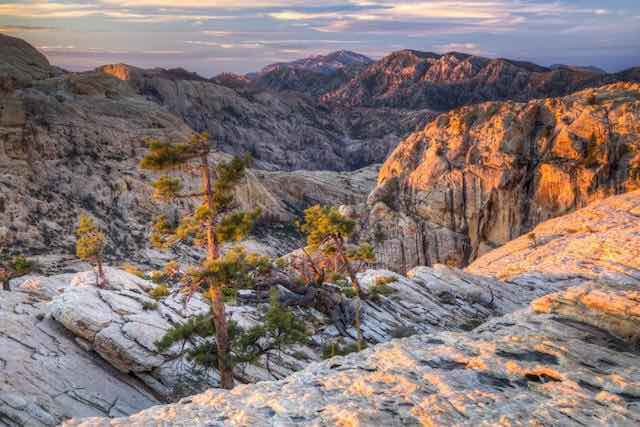

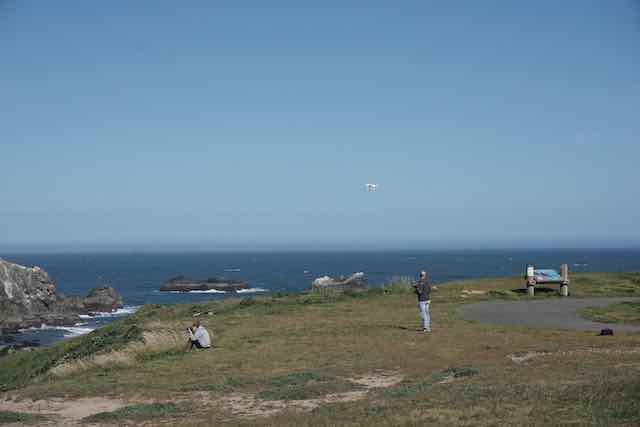







“You can thank the Sierra Club and other environmental groups for the Deepwater Horizon oil spill” -Antiplanner
This is the first time I have ever heard someone blame the Deepwater Horizon oil spill on Environmental groups. It makes you wonder if that was so why did BP plead guilty to 11 felony counts related to the deaths of the 11 workers or why families of workers killed in the explosion sued Transocean, BP, Halliburton and relevant subsidiaries and not those environmental groups. I’m curious who does the Antiplanner blame for the Exxon Valdez oil spill
From today’s WSJ …
.
“At the busiest part of the Grand Canyon, the South Rim, site to millions of tourists every year, sometimes water is a little hard to come by.
.
Restaurants rely on paper goods so they don’t wash dishes. They don’t serve glasses of water unless asked. Hotels switch to low-water cleaning for their rooms.
.
The desert isn’t the problem—it is the pumps, and it has been for years. At least as far back as the 1990s the park’s water pumps failed 10 to 12 times a year, with each outage costing $15,000 to repair. The problem is still outstanding, and the park hasn’t had the money needed to fix it, now estimated to be $52 million, according to the National Park Service.”
.
https://www.wsj.com/articles/from-yellowstone-to-yosemite-national-parks-to-get-long-awaited-overhaul-11596533401?
“Today, except for some parks and forests in Alaska, virtually every national park and forest is a few minutes away from a city whose private landowners would be happy to rent housing to government employees.”
Total BS, Randal. You’re completely out of touch with rural housing trends.
.
There’s a drastic shortage of rural housing in this country, and it’s worse near national parks, thanks in part to vacation rentals.
.
Look at Crater Lake for example. Look at Craigslist and Zillow in Fort Klamath or Union Creek and you’ll find zero for rent. One in Shady Cove. That leaves an hour commute to the shithole that is Klamath Falls, which has a major housing shortage due to the Air Force and only two rentals listed on Zillow and a bunch of scams listed on CL. Or a 90 minute commute to Medford, which also has a housing shortage. That commute time can triple in winter. This is not “a few minutes away.”
.
Also, do you really think it’s practical to have emergency personnel living an hour+ away from the park?
.
In addition, many workers are seasonal, and there are even fewer affordable short-term rentals. Near Crater Lake, these owners would be more happy to rent their property on Airbnb, where they will make a fortune compared to renting to NPS employees. For example, this small cabin rented for $600 a month in the early 2000s. Now it’s going for $200 A NIGHT (and is booked solid in summer) on VRBO.
https://www.vrbo.com/4249623ha?adultsCount=1&noDates=true
.
This is true for parks throughout the West: Zion, Arches, Rainier, Sequoia, etc, etc.
.
Please research before making silly statements that show how out of touch with reality you are.
Frank,
If there is such a housing shortage, how is it that employees of the Rogue River and Winema national forests, which surround Crater Lake National Park, don’t seem to have a problem finding housing?
Why does nature require so much Human maintenance
It doesn’t..
that’s reserved for cabins, utilities, sewage
Forest management of invasive species
fire prevention
They’ve tried forest fire prevention for 90 years and they don’t work. Let it burn and replant the area.
“If there is such a housing shortage, how is it that employees of the Rogue River and Winema national forests, which surround Crater Lake National Park, don’t seem to have a problem finding housing?”
First, you’re making the assumption that they don’t have problems finding housing. As previously mentioned, the Rogue Valley and the Klamath Basin have serious housing shortages.
Second, the Rogue River-Siskiyou National Forest headquarters is in Medford in a massive building filled with cubicles. When employees need to do fieldwork, they check out a government rig and drive to the field. Just because those national forests abut the park, that doesn’t mean that personnel need to be stationed there, although seasonal employees are, especially fire fighters. See Union Creek for an example.
Those forests receive fairly little visitation in comparison to Crater Lake, which receives three-quarters of a million people in 3 months. The Park is open year-round though. For both of these reasons it’s essential to have law enforcement and other emergency personnel housed centrally and not 90 minutes away.
Finally, unlike the USFS, many if not most Crater Lake employees (including maintenance workers, fire fighters, law enforcement, biologists, interpreters/naturalists, etc.) are seasonal, and finding a three-month rental is damn near impossible.